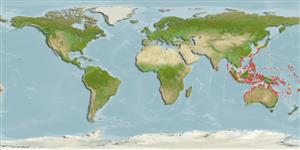>
Gobiiformes (Gobies) >
Gobiidae (Gobies) > Gobiinae
Etymology: Gobiodon: Latin, gobius = gudgeon + Greek, odous = teeth (Ref. 45335).
Environment: milieu / climate zone / εύρος βάθους / distribution range
Οικολογία
Θαλασσινό(ά) Υφαλόφιλο(α); εύρος βάθους 0 - 8 m (Ref. 94251). Tropical
West Pacific: Indonesia, Cocos Is., Japan (Ryukyu Is.), Micronesia (Ponape), Australia and Papua New Guinea.
Μέγεθος / Βάρος / Age
Γεννητική Ωρίμανση: Lm ? range ? - ? cm
Max length : 5.4 cm TL αρσενικό/απροσδιόριστο; (Ref. 11344)
Short description
Κλείδες προσδιορισμού | Μορφολογία | Μορφομετρία
Ραχιαίες άκανθες (συνολικά) : 7; Μαλακές ραχιαίες ακτίνες (συνολικά) : 10 - 11; Εδρικές άκανθες: 1; Μαλακές εδρικές ακτίνες: 8 - 10; Σπόνδυλοι: 26. This species possess many reddish spots/stripes on a yellow-green or sky-blue body; when alive or freshly-collected, it can be distinguished from similar reddish-spotted/lined congeners (G. aoyagii and G. histrio), by having the following set of details in color: 5-6 (usually 5) vertical reddish bars on head and pectoral-fin base; bars on cheek and operculum relatively short, usually not or barely reaching dorsally beyond a level of dorsal margin of eye; 3-8 longitudinal series of rounded or longitudinally elongate scarlet/reddish spots on body, sometimes continuous and forming longitudinal stripes; dorsal, anal and caudal fins are pale yellow with very narrow black distal margins; absence of a black spot at dorsoposterior corner of operculum. In alcohol-preserved specimens, all reddish spots are largely or entirely faded, but this species can still be distinguished from congeners by having a deep, inflected interopercle-isthmus groove; a series of minute non-imbricate cycloid scales on midlateral body; 6-7 upper or lower unsegmented caudal-fin rays; absence of a distinct dusky spot at dorsoposterior corner of operculum. Urogenital papilla in males are more narrowed distally and nearly triangular, while is females it is broader and nearly rectangular (Ref. 94251).
Body shape (shape guide): short and / or deep; Cross section: oval.
Facultative air-breathing (Ref. 126274); This species is observed to be found among branches of table-like corals, usually Acropora nasuta, also A. valida, A. millepora (the coarse branched form) and sometimes
A. tenuis (Ref. 94251).
Life cycle and mating behavior
Γεννητική Ωρίμανση | Αναπαραγωγή | Γεννοβολία | Αβγά | Γονιμότητα | Προνύμφες
Bi-directional sex change has been confirmed for this species (Ref. 103751).
Shibukawa, K., Suzuki, T. and M. Aizawa, 2013. Gobiodon aoyagii, a new coral goby (Actinopterygii, Gobiidae, Gobiinae) from the West Pacific, with redescription of a similarly colored Congener Gobiodon erythrospilus Bleeker, 1875. Bull. Nat. Mus. Nat. Sci. 39(3):143-165. (Ref. 94251)
IUCN Red List Status (Ref. 130435: Version 2025-1)
Threat to humans
Harmless
Human uses
Εργαλεία
Special reports
Download XML
Διαδικτυακές πηγές
Estimates based on models
Preferred temperature (Αναφ.
123201): 24.6 - 29.3, mean 28.5 °C (based on 1991 cells).
Phylogenetic diversity index (Αναφ.
82804): PD
50 = 0.5000 [Uniqueness, from 0.5 = low to 2.0 = high].
Bayesian length-weight: a=0.01995 (0.00906 - 0.04395), b=3.01 (2.83 - 3.19), in cm total length, based on all LWR estimates for this body shape (Ref.
93245).
Τροφικό Επίπεδο (Αναφ.
69278): 3.4 ±0.5 se; based on size and trophs of closest relatives
Ελαστικότητα (Αναφ.
120179): Υψηλό, ελάχιστος χρόνος για διπλασιασμό πληθυσμού < 15 μήνες (Preliminary K or Fecundity.).
Fishing Vulnerability (Ref.
59153): Low vulnerability (10 of 100).
🛈
Nutrients (Ref.
124155): Calcium = 207 [89, 434] mg/100g; Iron = 1.03 [0.49, 2.13] mg/100g; Protein = 18 [16, 20] %; Omega3 = 0.111 [0.043, 0.230] g/100g; Selenium = 19.7 [8.8, 44.3] μg/100g; VitaminA = 92.3 [22.1, 375.0] μg/100g; Zinc = 2.23 [1.36, 3.55] mg/100g (wet weight);
